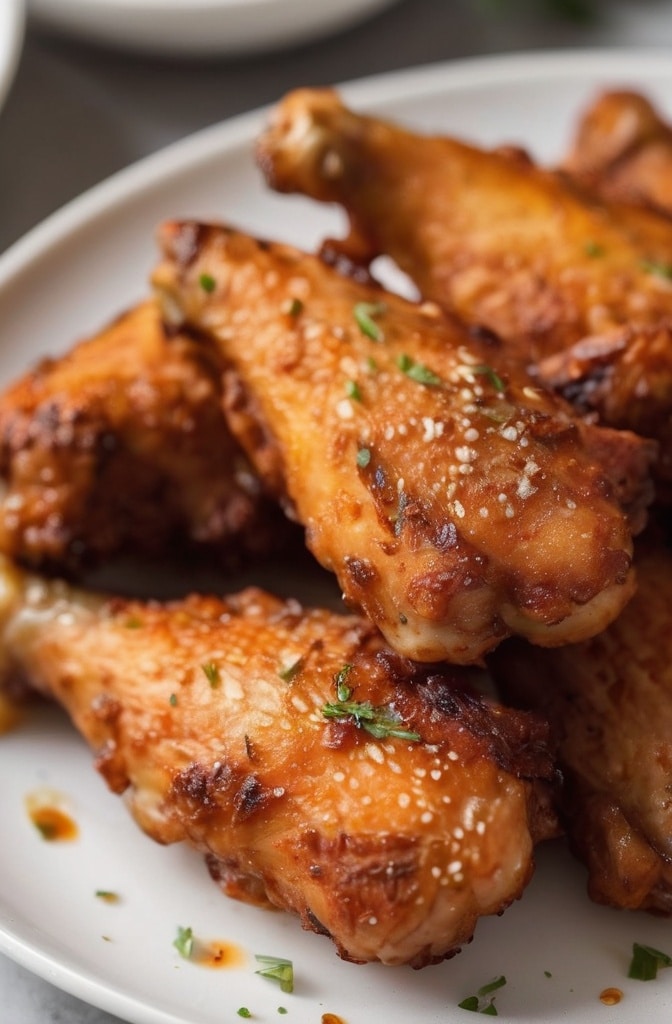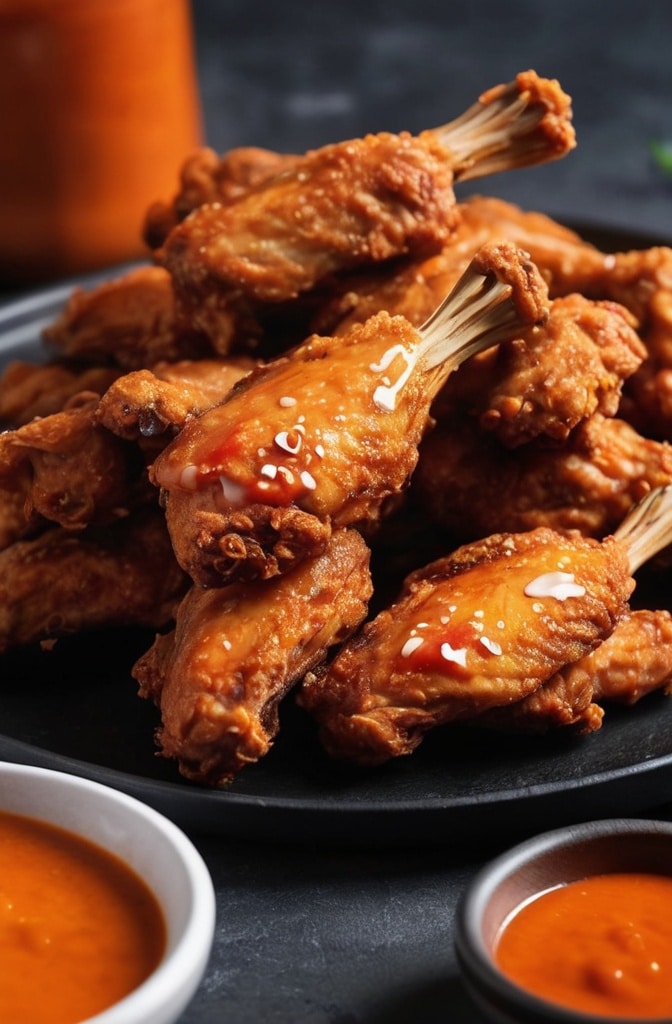I still remember the first time I tried making a Crispy Air Fryer Chicken Wings Recipe. The skepticism was real how could a countertop appliance possibly deliver the same satisfying crunch as deep-frying? But that first bite silenced all my doubts. The skin crackled between my teeth while juicy meat pulled effortlessly from the bone. It was a revelation that transformed my approach to home cooking.
Air fryer chicken wings aren’t just a convenient alternative; they’re often superior to their deep-fried counterparts. By circulating super-heated air around the wings, the air fryer creates a consistently crispy exterior while keeping the inside tender and moist. And the best part? You’ll use about 80% less oil than traditional methods. It’s a win-win situation for both flavor and health consciousness.
Let’s dive into creating the perfect crispy air fryer wings that will rival any restaurant offering. I’ve spent years refining this technique, and I’m excited to share every tip and trick I’ve gathered along the way. These aren’t just good “for air fryer wings”—they’re exceptional wings, period.
Ingredients & Substitutions
For the Wings:
- 2 pounds fresh chicken wings, separated into drums and flats
- 1 tablespoon baking powder (aluminum-free preferred)
- 1 teaspoon kosher salt
- ½ teaspoon freshly ground black pepper
- ½ teaspoon garlic powder
- ½ teaspoon onion powder
- ¼ teaspoon paprika
For Classic Buffalo Sauce (Optional):
- ½ cup Frank’s RedHot original sauce (or similar cayenne pepper sauce)
- 4 tablespoons unsalted butter, melted
- 1 tablespoon white vinegar
- ¼ teaspoon Worcestershire sauce
- ¼ teaspoon garlic powder
The quality of your wings matters tremendously. Fresh wings will always produce better results than frozen, though frozen ones can work in a pinch—just thaw them completely and pat them very dry. The baking powder might seem unusual, but trust me, it’s the secret weapon. It alters the pH of the chicken skin, helping it break down and crisp up during cooking. Just make sure to use aluminum-free baking powder to avoid any metallic aftertaste.
If your watching sodium intake, you can reduce the salt slightly—but don’t eliminate it entirely, as it’s crucial for flavor development. For those avoiding dairy, the buffalo sauce can be made with plant-based butter alternatives, though the flavor profile will shift subtly. Coconut oil isnt ideal here due to its distinctive taste.
Step-by-Step Instructions

Preparing the Wings
- Pat the chicken wings completely dry using paper towels. This step cannot be overstated—excess moisture is the enemy of crispness. I sometimes leave them uncovered in the refrigerator for an hour to further dry the surface.
- In a large bowl, combine the baking powder, salt, pepper, garlic powder, onion powder, and paprika. Toss the wings in this mixture until evenly coated. The baking powder mixture creates magic here, drawing out moisture during cooking and creating that coveted crispy texture.
- Let the seasoned wings rest for at least 30 minutes at room temperature, or ideally, place them on a wire rack over a baking sheet in the refrigerator for 2-4 hours. This resting period allows the baking powder to work its science on the skin and helps the seasonings penetrate the meat.
Air Frying the Wings
- Preheat your air fryer to 380°F (195°C) for about 3 minutes. Preheating is essential for immediate searing and proper cook times.
- Arrange the wings in a single layer in the air fryer basket, making sure they don’t overlap or touch if possible. You’ll likely need to cook in batches depending on your air fryer size. Overcrowding is a common mistake that results in steaming rather than crisping.
- Cook for 12 minutes, then flip the wings and increase the temperature to 400°F (205°C). Cook for an additional 6-8 minutes until the skin is deeply golden and crisp. The two-temperature approach gives you perfectly cooked interiors with maximally crispy exteriors.
- If your making multiple batches, you can keep the finished wings warm in an oven set to 200°F (95°C) while you complete the remaining batches.
Preparing the Buffalo Sauce (If Using)
- While the wings are cooking, melt the butter in a small saucepan over low heat or in the microwave.
- Whisk in the hot sauce, vinegar, Worcestershire sauce, and garlic powder until fully combined. The butter smoothes out the sauce’s capsaicin punch, creating that classic buffalo flavor profile.
- Keep the sauce warm until ready to use, or reheat briefly before tossing with the wings.
Finishing the Wings
- Transfer the cooked wings to a large bowl. If using buffalo sauce, pour it over the wings and toss until evenly coated. Work quickly while the wings are still hot—they’ll absorb the sauce better.
- For dry-rubbed wings, toss them with your favorite seasoning mix immediately after cooking. The residual heat helps the flavors adhere to the crispy skin.
- Serve immediately with celery sticks, carrot sticks, and blue cheese or ranch dressing on the side. Timing is everything—the sublime experience of crispy-yet-saucy wings deteriorates with each passing minute.
Cooking Techniques & Science
The magic of air fryer wings lies in understanding the science of crispy skin. Chicken skin consists primarily of protein and fat. When exposed to high heat, the proteins denature and form a rigid structure while the fat renders out, creating that glorious crispy texture we crave. The circulating hot air of the air fryer performs this transformation more efficiently than conventional ovens.
The baking powder plays a crucial duel role in this process. First, its alkaline nature disrupts the protein structures in the skin, allowing them to crisp more readily. Second, it combines with the skin’s natural moisture to create tiny carbon dioxide bubbles, which help form a more textured, crackly surface. This is similar to how it functions in baking to create lift and texture.

Temperature control is another critical factor. Starting at a slightly lower temperature allows the fat to render gradually without burning the skin. The final high-temperature blast creates the Maillard reaction—the complex chemical process that creates browned, flavorful compounds on the surface of the food.
Different air fryer models perform variously, so you may need to adjust times slightly. Basket-style air fryers typically work better for wings than oven-style models because they allow better air circulation around the individual pieces. If you’re using an oven-style model, consider placing a wire rack inside to elevate the wings for better air flow.
Serving & Pairing Suggestions
Presentation elevates these wings from casual snack to impressive offering. Arrange them in a spiral pattern on a round platter or stack them Lincoln-log style on a rectangular plate. A sprinkle of finely chopped fresh parsley or thinly sliced green onions adds a pop of color and freshness.
Traditional accompaniments like celery and carrot sticks aren’t just decorative—their cool crunch and subtle sweetness provide the perfect counterpoint to the wings’ rich, spicy profile. For dipping sauces, homemade blue cheese dressing made with buttermilk and crumbled Gorgonzola offers tanginess that commercial versions can’t match.
For beverage pairings, the classic choice is cold beer—particularly hoppy IPAs that stand up to the wings’ bold flavors. Non-alcoholic options include tart lemonade or crisp ginger beer, both of which cut through the richness perfectly.
For a complete meal, consider serving these wings alongside cooling sides like creamy coleslaw, potato salad, or a crisp green salad with ranch dressing. If you’re hosting a game day gathering, these wings pair wonderfully with other finger foods like loaded potato skins, spinach-artichoke dip, or jalapeño poppers.
Beyond Buffalo: Flavor Variations
While buffalo sauce is the classic choice, these perfectly crispy wings serve as an excellent canvas for countless flavor profiles:
- Korean-Style: Toss with a mixture of gochujang (Korean chili paste), honey, soy sauce, garlic, and a splash of rice vinegar for sweet-spicy-umami perfection.
- Lemon Pepper: Mix butter with freshly grated lemon zest, cracked black pepper, and a touch of garlic powder for a bright, zesty profile.
- Honey Garlic: Combine equal parts honey and soy sauce with minced garlic, a splash of rice vinegar, and a pinch of red pepper flakes.
- Caribbean Jerk: Coat with a paste of scallions, thyme, allspice, nutmeg, cinnamon, habanero peppers, brown sugar, and lime juice before air frying.
- Garlic Parmesan: Toss hot wings with melted butter, minced garlic, grated Parmesan cheese, and chopped parsley for an Italian-inspired variation.
Remember that sauced wings will begin to lose their crispness shortly after tossing, so serve them immediately for the best texture experience. For make-ahead situations, keep the sauce separate and toss just before serving.
Make-Ahead and Storage Tips
While these wings are best enjoyed fresh from the air fryer, real life sometimes requires flexibility. If you need to prepare ahead, you can season the wings with the baking powder mixture up to 24 hours in advance—in fact, this extended dry-brining period can improve results. Store them uncovered on a wire rack in the refrigerator to maximize surface drying.
Leftover cooked wings (if such a thing exists!) can be refrigerated for up to three days. To reheat, place them in the air fryer at 375°F for 3-4 minutes, which will restore much of their original crispness. Microwaving is not recommended as it creates a soggy texture thats dissapointing.
For larger gatherings, you can pre-cook the wings at 380°F until almost done (about 20 minutes), refrigerate, then finish with a high-temperature blast just before serving. This approach saves time during the event while still delivering crispy results.
Conclusion
Mastering crispy air fryer chicken wings is about understanding the science of texture and the art of flavor. The method outlined here—thoroughly drying the wings, using baking powder, proper temperature control, and avoiding overcrowding—yields restaurant-quality results with significantly less oil than traditional frying.
Whether you’re serving classic buffalo wings for game day or experimenting with global flavor profiles for a dinner party, this technique provides a reliable foundation for wings that consistently impress. The air fryer hasn’t just made wing preparation more convenient; it’s actually improved upon the traditional method in terms of texture consistency and health profile.
Remember that patience is key to exceptional wings—from the initial drying process to cooking in properly spaced batches. The results are well worth the attention to detail: impossibly crispy exteriors giving way to juicy, flavorful meat that pulls cleanly from the bone. That’s the hallmark of truly great chicken wings, and with this method, you can achieve it reliably at home.
FAQs Crispy Air Fryer Chicken Wings
Why aren’t my air fryer wings getting crispy?
The most common culprits are excess moisture and overcrowding. Make sure to pat the wings completely dry before seasoning and cook them in a single layer without touching. Also, check that you’re using baking powder (not baking soda), as it’s crucial for achieving the crispy texture.
Can I use frozen wings for this recipe?
Yes, but with modifications. Thaw them completely first, then pat very dry before proceeding. Frozen wings contain excess moisture that can prevent proper crisping. In a pinch, you can cook from frozen by adding 5-7 minutes to the cooking time, but the results won’t be quite as crispy.
How can I make the wings spicier or milder?
For spicier wings, add cayenne pepper to the dry seasoning mix and/or increase the hot sauce-to-butter ratio in the buffalo sauce. For milder wings, reduce the hot sauce and increase the butter, or choose a less spicy sauce variety. You can also create a “spice bar” with different sauce options so guests can customize to their preference.
My air fryer is smoking when cooking wings. What’s wrong?
This typically happens when rendered fat drips onto the heating element. To prevent this, some cooks add a tablespoon of water to the bottom of the air fryer drawer (under the basket) to prevent smoke. Clean your air fryer thoroughly between batches, especially if cooking multiple rounds of wings.
Can I make these wings ahead of time for a party?
For the best results, cook the wings just before serving. However, you can prepare them up to the point of air frying several hours ahead. For large gatherings, consider the par-cooking method described in the storage section, then finish them in batches as needed throughout your event.

